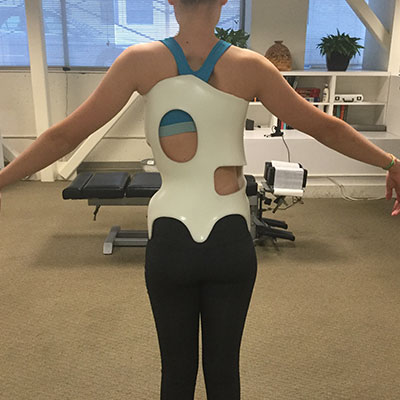ScoliBrace® for Children & Teens
Dr. Rob specializes in treating scoliosis in children, adolescents and teens using the ScoliBrace.
Corrective
Built For You
Easier to Wear
Corrective
Built For You
Easier to Wear
Scoliosis in Children & Teens
Scoliosis can affect infants, children and teens of all ages. Early detection is important so that you have a wide range of treatment options. Treatment may range from “watching and waiting,” physical medicine (CBP care), and/or bracing.
Having a child diagnosed with scoliosis can be stressful for both the parent and child. We understand that it is difficult to learn your child has been diagnosed with scoliosis. The good news is in most cases, effective treatment significantly reduces the risk of surgery or other negative outcomes. Dr. Rob makes every effort to ensure your child’s comfort, both physically and mentally, during treatment.
Dr. Rob recommends ScoliBrace as the most discreet and easy-to-wear brace option. We work with allied healthcare providers, school teachers and other caregivers to make wearing the brace as easy as possible.
Infantile Scoliosis
Infantile scoliosis develops in children under the age of 4 and is fortunately rare, but some patients do require bracing to manage the curves as they develop. Initial treatment for these cases often involves casting to stabilize the curve. Once the curve is reduced by casting, curves larger than 20 degrees usually require hard bracing to maintain the correction and to prevent further progression.
Juvenile Scoliosis
Juvenile scoliosis develops between the age of 4 and 10 years old and is more common than infantile scoliosis, but less common than adolescent scoliosis. Juvenile scoliosis is often called “early onset adolescent scoliosis” because it is similar to adolescent idiopathic scoliosis. The primary difference is that the treatment window is much longer, therefore bracing is almost always necessary at some point before skeletal maturity.
- Bracing is often required with curves greater than 20 degrees (15 degrees with significant family history).
- Curves under 20 degrees can often be managed with CBP chiropractic rehabilitation and may not require bracing. If the curve is greater than 20 degrees (15 degrees with significant family history) the ScoliBrace is used to stop further progression and even correct the curve. If the curve is reduced and stable, a pause in bracing may be possible from time to time before skeletal maturity.
Unfortunately, some cases will require surgery. Surgical intervention involves placing rods in the spine along with spinal fusion. Curves greater than 45 degrees are often considered for surgical intervention. In some cases, curves over 45 degrees may respond well to the ScoliBrace to delay surgery until the patient is closer to or at skeletal maturity. This may help avoid the need for expansion rods and multiple surgical procedures.
Adolescent Idiopathic Scoliosis
Adolescent Idiopathic scoliosis (AIS) affects children between the age of 10 and 18 years old and is present in about 4% of the population. Females account for 90% of these cases. These curves are often first discovered around puberty and can progress until skeletal maturity. Treatment depends on the size of the curve and other factors.
- Curves 20 degrees and under. (15 degrees with family history.) Can often be managed with CBP chiropractic rehabilitation to slow progression in hopes to avoid needing a hard brace.
- Curves greater than 20 degrees with risk of progression. (15 degrees with family history.) Should be managed with a scoliosis brace. Risk of progression is determined by analyzing family history and by assessing the skeletal maturity of the patient by using the Risser method on x-ray.
- Cases with large curves and more time until skeletal maturity have the greatest risk of progression and poor outcomes without treatment.
- Patients close to skeletal maturity with curves under 45 degrees are less likely to have curve progression and may not need a brace.
- Patients with curves over 45 degrees at skeletal maturity are often referred for an orthopedic surgeon to determine the need for surgery.
Success Stories

Before 1:
Thoracic

Before 2:
Lumbar

Wearing the ScoliBrace

After 1:
Thoracic

After 2:
Lumbar
Schedule a Free Consultation
Find out how Dr. Rob Privratsky can help you stop the progression of your scoliosis.